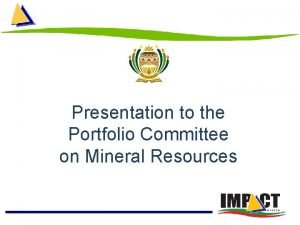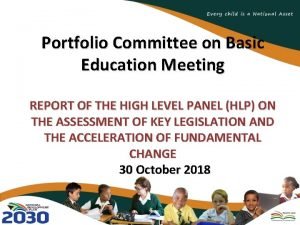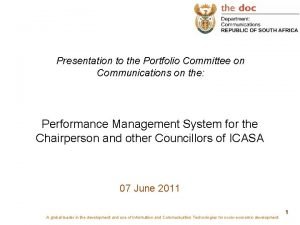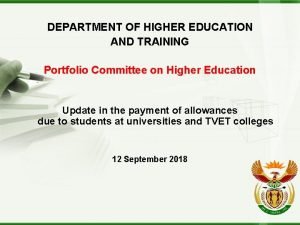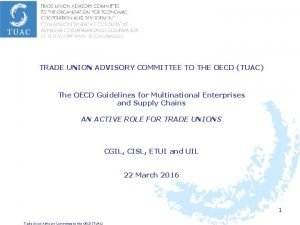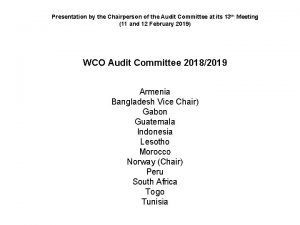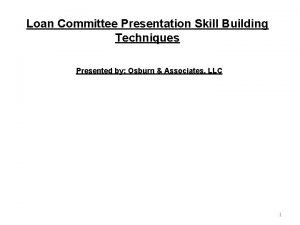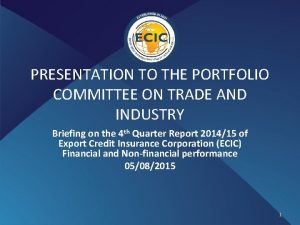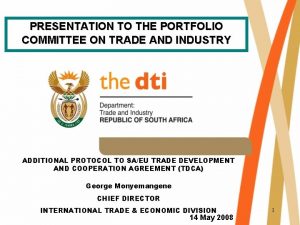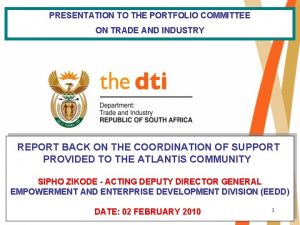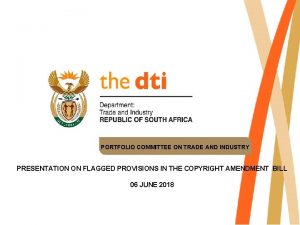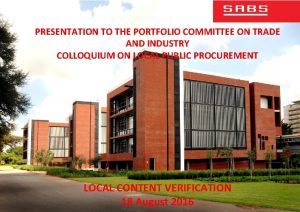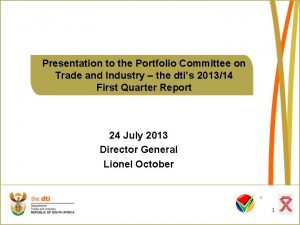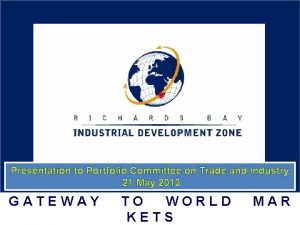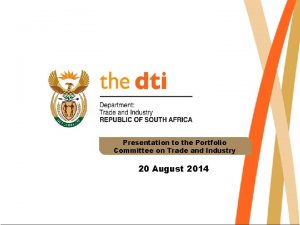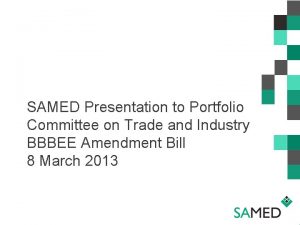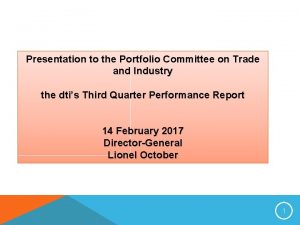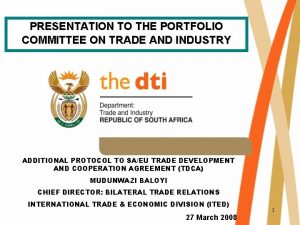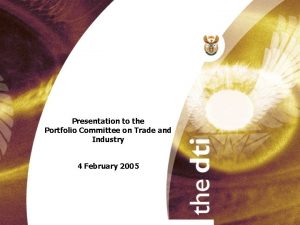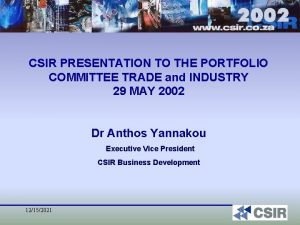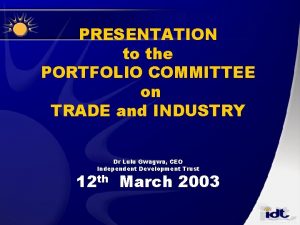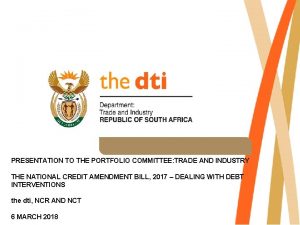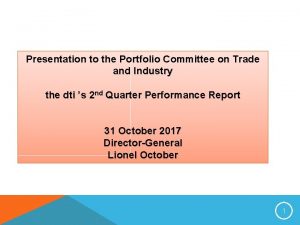PRESENTATION TO THE PORTFOLIO COMMITTEE ON TRADE AND





































- Slides: 37

PRESENTATION TO THE PORTFOLIO COMMITTEE ON TRADE AND INDUSTRY PROVISIONS IN THE COPYRIGHT AMENDMENT BILL 31 MAY 2018

Presenters Dr Evelyn Masotja Deputy Director General, CCRD Ms Pregoria Mubaso Muvhango Director: Legislative Drafting Mr Nkosinathi Mkhonza Administrative Clerk: IP Law and Policy 2

Purpose of the Presentation To present the Bill Clause by Clause to the Portfolio Committee on Trade and Industry. 3

PREAMBLE The preamble will change depending on the provisions of the Bill which will be retained or removed. DEFINITION CLAUSE • The definitions in clause 1 will be retained. • This includes among others the definition of accessible format copy which defines an alternative form which gives a person with disability access to the work as a person without disability , • the definition of audiovisual work which is defined as the embodiment of moving images whether or accompanied by sound or by representation which can be perceived, reproduced or communicated through a device and include a cinematographic film. This expression also substitute the use of the phrase cinematographic film with audiovisual work and the phrase film with work in the entire Bill and Act, • Definition of Orphan work may have to be removed if we retain fair dealing. • Orphan work is work in which copyright subsists and the owner of right can not be identified or can be identified but can not be located. 4

Clause 2 insertion of section 2 A dealing with Scope of copyright protection There are certain activities that are not protected by Copyright because of their nature. For example, one cannot take a publicly produced or known concept and claim it as a copyright. There is an international trend to move away from promoting copyright protection that do not reflect creative activity but merely the outcome of a skill and efforts. -US, EU, UK. Creative effort: illustration, description and explanation. Copyright does not protect ideas, procedure, methods of compilation, mathematical concepts, interface specifications (computer programs-e. g documents that capture an idea of a software, possible actions that can be taken). Some are developed and published by the Service Availability Forum (SA Forum) and made freely available. Interface specification example is manuals in boxes of say DVD players. Protection does not subsist to official texts of legislative, administrative or legal nature or speeches of a political nature or speeches delivered in the course of legal proceedings or in news of the day that are mere items of press information. the dti agrees with the DAC on the copyright protection. Clause 3: Amendme nt to Section 5 Work funded by the State The Clause confers copyright on the work eligible for copyright which is funded by or under the direction or control of the state or international or local organizations. It addresses public funding for e. g research and development using funds allocated by government or government agencies. This is problematic because government funds many things and they cannot be perceived as copyright, e. g the dti incentives. It was proposed that the words funded be removed in this clause. 5 the dti agrees with the DAC on removing the words ‘funded by’.

Clause 4: Amendment to section 6 Communicating of literal and musical work to the public Clause Copyright in literal or musical work vest an 4: To be removedexclusive right to or authorize the doing of literal work among other things: communicating the work by wire or wireless means to the public so that work may be access at the time chosen by that person. Clause 5: insertion of section 6 A Royalties regarding literal or musical work. Policy issue: The authors have been deprived of the right to their royalties. This provision aims to ensure royalties are paid for creative work. In the music industry, provision was made, however not specific and it was abused. Allows the author who transfers copyright in literal or musical work to have a right to claim half of the royalty payable to that other person for the use of the copyright work. the contract to be the first option. the dti agrees with the DAC that unfair contracts must be addressed. Clause 5, 7 and 9, cannot legislate for 50/50 split in all categories as they operate differently in practice. Contract will be respected, but as a policy position we propose minimum standard contract template for all categories. In the legislation there should be a provision that enables the Minister to prescribe minimum requirements of the agreement but the specifications will be dealt 6 with in Regulations.

Proposed “ 6 A 1(a) In the absence of an agreement to the contrary, no person may reproduce, broadcast, cause the publishing of the work or perform the work in the public as contemplated in section 6 (a)(b)(c) and d without payment of royalty to the owner of the relevant copyright. The amount of any royalty contemplated in paragraph (a) shall be determined by an agreement between the composer, the publisher and the owner of the copyright, or between their representative collecting societies. (c) In the absence of an agreement contemplated in paragraph (b), the composer, the publisher or the user the royalty may refer the matter to the Copyright Tribunal in terms of this Act”. E. G of minimum Clause 5: contract Suggested drafting requirements • Dispute resolution • Term of contract • Exit clauses for artists • Sharing splits • Rights of parties 7

Clause 6 amendment section 7 Communicating artistic work to the public. Policy: this clause is to ensure Clause 6: to be retained creative work is available in any format, anywhere at any time. The Bill is from 1978, much has occurred in Copyright over time, the Act not in line with technological developments. Copyright in artistic work vest an exclusive right to or authorize the doing of among other things: communicating the work by wire or wireless means to the public so that work may be access at the time chosen by that person. Clause 7 insertion of section 7 A Royalties regarding artistic works Policy: When compared with other copyright works, one cannot reproduce a painting for example. Revenue stream is from sales. The intention of the provision is to provide for royalties in artistic works. 8

Artist Resale Right (ARR): The history of the incorporation of ARR in the UK is especially relevant to South Africa because its copyright law is essentially British. With regard to the rate, in the UK the royalty depends on the resale price and it is worked out according to a sliding scale from 4% to 0. 25% with a threshold of € 1, 000 and up to qualify for a royalty. Australia, California in the USA and Senegal have a fixed rate of 5%. Countries have the policy space to decide on whether to opt for a fixed or sliding scale and both are acceptable to this right. Proposal for CAB: fixed rate which must be determined by the two Ministers jointly. The proposal by the DAC to set the rates upfront is noted. With regard to pays the royalty, in the UK the ARR Regulations 2006 state that principally the art market professional and the seller of the artwork are “jointly and severally liable” for the payment of the royalty. With regard to collection of the ARR, the UK has made Collective Management of ARR compulsory, therefore no direct payments may be made directly to the author of the work. Proposal for CAB: That royalty should be administered through Collective Management. The dti agrees with the DAC. The Collecting Societies collecting on ARR have the responsibility to facilitate the disclosure of information regarding payment. With regard to works covered by the ARR, the Senegalese Copyright Act provides that ARR does not apply to architectural works or works of applied art. It must be noted that there is no international treaty on ARR. DAC: Senegalese model, rates set Clause 7 statute. retain Liability for upfront by the payment of the royalties should be well stipulated, whether it is by the seller or the buyer. And who will be subjected to collect the royalties. Delete the insertion of 7 A: Artistic work cannot be reproduced, the nature of the work for artistic work is different from the other works. The royalty for artistic work is created by the resale of the work as contemplated by the insertion of section 7 B. 9

Insertion of section 7 B resaleroyalty right regarding artistic works It proposes that royalties in artistic works on commercial resale to be payable at the rate prescribed by Minister. Artists of visual art can sell their work, at a fairly low price, over time the art sold appreciates. For the artist to receive a royalty, everytime the art is resold. Will not apply to architectural and engineering drawings, circuit layouts, commercial logos and icons for applications. Other jurisdictions have specific legislation on Artist resale rights. It sets out grounds of an author who shall be entitled to such resale royalty: he must be a South African citizen when resale is concluded even at time of death if author is deceased, validity of the resale of royalty right has not expired. The non citizens must be catered for. The principal Act provides for a South African citizen, or is domiciled or resident in the Republic. Insertionof section 7 C Proof of author In South Africa, there is no system to register copyright work and the basis of copyright is originality and that it is in written format. A person if deemed to be author where a mark or name purporting to identify as author of an artist appear on such work. 7 B 7 Bmay be DAC: Concern of. Section reciprocity. (a) requires resale royalties be given to removed South African citizens or residents-this may undermine the principle of reciprocity. A system in which SA would determine the number of permits it grants to nationals of another country on the basis of how many permits that country grants South Africa, for example. The World Trade Organisation’s Agreement on Trade Related Aspects of Intellectual Property Rights allows for reciprocity of intellectual property protection if similar rights are offered in the country of origin. This means that foreign resale royalty right schemes can only be accessed by a country if its domestic law permits it, and only if it has a similar scheme open to nationals of the country from which the right is being claimed. 10

Insertion of section 7 D resale of royalty right 7 D with may. DAC. be it should An visual artist-sells an art piece and sells it at a very low Section price, Agree over time it appreciates. The artist should be able to receive removed be visual artists catered royalty each time the art piece is resold. for. The clause proposes that the resale of royalty right of an author of an artistic work expires at the end of 50 years calculated from the end of the calendar year in which the author died, for more than one author when the last known author dies. This provision will ensure that the family of the artists receive their royalties long after they have died. This is in line with the UK, France, Morocco system on artist resale. Other countries have specific laws to address artist resale rights such as the UK. Where author is unknown at the end of the period of 50 years calculated from the end of the calendar year in which the work was first made available to the public. Insertion of section 7 E transmissio n of resale royalty right The section provides that a resale royalty right may not be alienated save for transmission on death of holder through testamentary disposition (a will) or operation of law. The institutions in the dti legislation, the community Trusts to be removed. The DST institutions will be utilised. 11

Clause 8 amendment to section 8: Nature of copyright in audiovisual works The provision substitutes the use of the phrase film with work in this section. It also allows for copyright in audiovisual film to vest exclusive right and authorize communicating the work by wire or wireless means to the public. To align with the performers protection amendment Bill as it affects the actors and treaties such as Wipo Copyright Treaty. Clause 9 insertion of section 8 A Royalties regarding audiovisual works This provision is to empower authors in audio visual works to receive royalties. The intention is not to transfer. Has implications for the Performers Protection Bill. Allows the author who transfers copyright in audiovisual work to have a right to claim half of the royalty payable to that other person for the use of the copyright work. Clause 8: may be removed Clause 5, 7 and 9 – cannot legislate for 50/50 split in all categories as they operate differently in practice. Contract will be respected, but as a policy position we propose minimum standard contract template for all categories. In the legislation there should be a provision that enables the Minister to prescribe minimum requirements of the agreement but the specifications will be dealt with in Regulations. the dti agrees with the DAC regarding the split of 50% amongst authors, performers and producers, the right to receive royalty and the contract. 12

Clause 9 insertion of section 8 A Royalties regarding audiovisual works This provision is to empower authors in audio visual works to receive royalties. The intention is not to transfer. Has implications for the Performers Protection Bill. Allows the author who transfers copyright in audiovisual work to have a right to claim half of the royalty payable to that other person for the use of the copyright work. “ 8 A 1(a) In the absence of an agreement to the Clause 8: may be contrary, no person may reproduce, broadcast the work, cause the film, in so removed far as it consist of images, to be seen in public or in so far at it consist of sound, to be heard in public, cause the transmission of the film as contemplated in section 8(1)(a), (b), (c ) and (d), without payment of a royalty to the owner of the relevant copyright. (b)The amount of any royalty contemplated in paragraph (a) shall be determined by an agreement between the user of the audio visual work, the performer and the owner of the copyright, or between their representative collecting societies. (c) In the absence of an agreement contemplated in paragraph (b), the owner of the copyright or the collecting society receives payment of a royalty shall ensure that such royalty is shared equally between the copyright owner and any performer whose performance is featured on the audio visual works in question and would have been entitled to receive a royalty in that regard as contemplated in section 5 of the Performers’ Protection Act”. 13

Clause 10 amendment to section 9 Communica ting to the public This provision is to enable sound recording to be available on wire and wireless format at any place and time to the public. Copyright in sound recording vests an exclusive right to, among other things communicating the sound recording by wire or wireless means to the public. This clause may have implications for the Wipo Copyright Treaty Clause 11 insertion of section 9 A Royalties regarding sound recording Provide certainty on sound recordings. Also to provide for the royalties. The section prohibits a person from transmitting sound recording, broadcast sound recording or communicate sound recording to the public without payment of royalty to the owner of copyright. The person who intends to so transmit, broadcast or communicate must submit a prescribe notice to the performer, copyright owner or collecting society of intention to either broadcast, transmit or communicate the sound recording. The notice must indicate date of performance and terms and conditions of the payment of royalties. Clause 10 to be retained Music log sheets are kept mainly by broadcasters, and that general music users tend not to retain any log sheets. Collecting societies are, therefore, not able to accurately distribute royalties based on music usage. In cases where there are no log sheets, collecting societies use the available usage information as a mechanism for distributing unlogged royalties. Furthermore, some of the submissions to the CRC requested an amendment to the legislation to force every music user to retain cue sheets in order to eliminate the above-mentioned problem.

Clause 11 To agree the performer or collecting society signs the notice with proposal. Where the person fails to submit the notice to the owner, performer or collecting society, he will notify them, pay the generally applicable licence fees as published by the owner or collecting society and pay the royalties calculated from date of first use regardless of whether the date was prior to coming into operation of this Act. Proposed clause: Any person intending to perform any act Music Log sheets contemplated in section 9 (c), (d) and (e) (which is broadcasting, transmission or communicating to the public), must at any time when performing, register the act in a log sheet and submit a report to the performer, copyright owner, collecting society as the case may be in the prescribed manner, keep record of information in respect of the use of sound recording and furnish it to the performer, copyright owner or collecting society to enable the collecting society to comply with its obligations under the Copyright Act, 1978, Performers Protection Act, 1967). DAC raised a concern about who constitutes a user. This could be defined. Parties may refer disputes in this regard to the Tribunal for adjudication. The Tribunal may order that payment of royalties be made into a trust account of an attorney pending finalization of terms and royalty payable. The provision further proposes that the performers share of the royalty will represent an equitable remuneration as determined by the agreement between the performer and the owner of the 15 copyright or the collecting society. The indigenous Community or National Trust to be removed.

Clause 11 continues Clause 11 With regard to notice/proper record keeping – user must register act/use in a log sheet and submit a report to the performer, copyright owner or collecting society as the case may be, keep record of information in respect of the use in question of sound recording and furnish it to the performer, copyright owner or collecting society as the case may be to enable the collecting society to comply with its obligation under the Copyright Act, 1978, Performers’ Protection Act, 1967). Refer to Regulation 7 (3) of 2006. Clause 11 Furthermore, with regard to terms and conditions of payment of royalty, it will be the responsibility of Collecting Societies. In addition, the Regulations require that the agreement itself should contain the terms and conditions prescribing payment. Those who do not belong to a collecting society, it is their responsibility to have agreements with users of their work which is cumbersome hence collective management is encouraged.

• Fair dealing: operates by exempting the use of copyright works for certain statutorily-defined purposes and only relates to particular types of works. Fair dealing is a closed list of specific exceptions. There is no statutory definition of what dealing is fair. • Despite the existence of exceptions for purposes of illustration for teaching and research, the legal uncertainly surrounding the use of works has led to the conclusion of agreements between the collecting societies and educational establishments to the financial detriment of the latter. • Fair Use: is a doctrine under copyright law that permits certain uses of a work without the copyright holder’s permission. Fair use exceptions include but not limited to criticism, parody , comment, news reporting, teaching , scholarship, or research. It allows users to make use of copyright work without permission or payment when the benefit to society outweighs the cost to the copyright holder. 17

Hybrid Model • • Singapore: Singapore’s fair dealing is modeled on the US Fair Use provisions (S 35 (2)). The US provisions of Fair Use are open. Open: refers to the fact that the exception is flexible and that the exception can apply potentially to any purpose and this model is followed in the US, Israel, Malaysia and other countries. Closed: refers to list systems like SA current fair dealing and can only be closed to the purpose listed in the clause. It may be argued as it was by some stakeholders during public hearings that it does not matter what you call the clause but rather how far you open up the exception. The Singapore model may be described as such Singapore remained with the exception being called Fair Dealing but opened up the exception by drafting it on the US Fair Use provision and adding the words ‘such as’-This involves a mixture of the general, fair use style factors for lawful use, combined with more specific fair dealing style requirements in certain cases. As both fair use and fair dealing this would require balancing the rigidity and certainty of one with the flexibility and uncertainty of the other.

• • The provision in the CAB is drafted in a similar style to the Singapore model however the words ‘such as’ were left out thus closing the exception rather than allowing for an open exception. Ultimately Singapore shaped its fair dealing provision on prevailing local circumstances, the legislative objective was to create an environment conducive to the development of creative works, and also facilitating greater investment, research and development in Copyright Industries. (Dan Tan, Singapore Academy Law Journal, (2016) 28 SAc. LJ). In 2006 Singapore amendment authorized fair dealing for any purpose thus doing away with lists of purposes. The Preamble of the WIPO Copyright Treaty affirms the “need to maintain a balance between the rights of authors and the large public interest, particularly education, research and access to information as reflected in the Berne Convention”. This could be used to direct interpretation towards an open construction of the listed exceptions, and to address this newly enshrined balance with a ‘fair use’ concept which takes into account the rights of authors and the rights of access to information.

Clause 12 substitute section 11 Nature of copyright in programmecarrying signal Clause 13 repeals section 12 Clause A signal embodying a program which is released and passes through a satellite. Copyright in programme carrying signal vests exclusive right to undertake or to authorize the, among other things, the communication of the work by wire or wireless means to the public. This clause has implications for Treaties such as the Performances and Phonograms Treaty. Section 12 provides for Fair Dealing Fair dealing currently sets out categories of acceptable uses. It provides that copyright is not infringed by fair dealing in literal work or musical work: for purposes of research or private study by person using the work or for personal or private use or for purposes of criticism or review of the work or for reporting current events in a newspaper, magazine or by means of broadcasting or in cinematograph film This provision requires for the name of the author to be mentioned as well as the source. 11 continues the dti position and the DAC are similar. DAC points out challenges with fair use, the dti recognised the issues with fair use. Fair use not considered by the dti. It opts for fair dealing with flexibility. The concern of the DAC concerning the personal use/private use of copyright is noted by the dti. Exploitation not desirable. Private copy levy the dti has no policy position on it. It can be included if Parliament proposes it.

Clause 14 insertion of section 12 A, 12 B, 12 C and 12 D General exceptions from copyright protection Section 12 A deals with uses specifically Clause 14 Fair Use to be authorized fair use in respect of work or removed performance of work not infringing copyright for purposes of research for private or personal use; for criticism or review; for reporting current events; scholarship, teaching and education; for comment, illustration, parody, satire, caricature or Section 12 A deals with usespastiche; specifically authorized use to in respect of work or preservation and fair access the performance of work not infringing copyright purposes of research for private collection of libraries, for archives and museums expanding access tocurrent undeserved or personal use; for criticismand or review; for reporting events; scholarship, teaching and education; forpopulations. comment, illustration, parody, satire, caricature or pastiche; preservation and access to the collection of libraries, archives and museums and expanding access to undeserved populations Test to Determine Fair use TEST TO DETERMINE FAIRNature USEof the work Amount and substantiality of the part of the • Nature of the work affected in relation to the whole of the work Purpose and character of the use (whether it is of commercial nature and what purpose it serves)

Clause 14 insertion of section 12 A, 12 B, 12 C and 12 D General exceptions from copyright protection Section 12 B copyright is not infringed in the Section 12 A following acts: 12 A(vii) Underserved Clause 14 population Fair Usecan to be beremoved. Any quotation – must not exceed reasonable The entire provision of making access to removed justifiable purpose. Source and author must be information is to ensure access. The term is too named. wide. Illustration in a publication, broadcast, sound or Section 12 B(f)(iii) visual record for purpose of teaching: the use Remove ‘public information’. must not exceed justified purpose; the source and name of the author must be mentioned if The aim is to provide information for non commercial purposes. It can read as “ such work is practicable Reproduction of work by broadcaster where the translated and communicated to the public for non Section 12 B copyright is not infringed in the following acts: purposes’. reproduction is intended for lawful broadcast and commercial before 6 months following reasonable the date of justifiable purpose. Source and author • Anydestroyed quotation – must not exceed the production or as agreed by owner of must making be named. the copyright work. If the work is an exceptional • Illustration in a publication, documentary nature it may broadcast, be preservedsound in the or visual record for purpose of teaching: archives the broadcaster the use mustofnot exceed justified purpose; the source and name of the author must be The reproduction in the press or by broadcasting mentioned if practicable of a lecture, address which is delivered in public if • Reproduction of work by broadcaster where the reproduction is intended for lawful such is for information purpose broadcast and destroyed before 6 months following the date of making the production Section 12 C provision allows for transient or Section 12 B(6): The term “exhaustion” refers to the or asincidental agreed by owner of the copyright work. If the workinis. IPan documentary copies or adaptations of work where principle lawexceptional that a right holder cannot prevent the such are integral and essential part archives of technicalof the further distribution or resale of goods after consenting nature it may be preserved in the broadcaster process and where the purpose of those copies is to the first sale (reason why it is also known as the The to reproduction in the press by broadcasting ofdoctrine”). a lecture, is on the enable transmission of work in aor network “first-sale Onceaddress a good haswhich been put between third parties or toisadapt work to allow purpose market by or with the consent of the right owner, further delivered in public if such for information Clause 14 insertion of section 12 A, 12 B, 12 C and 12 D General exceptions from copyright protection • use in a different device. circulation of that good can no longer be controlled by him. The right holder is considered to have “exhausted” his rights over those goods.

Section 12 C temporary reproducti on and adaptation: Provision allows for transient or incidental copies or adaptations of work where such are integral and essential part of technical process and where the purpose of those copies is to enable transmission of work in a network between third parties or to adapt work to allow use in a different device. Clause 14 insertion of section 12 A, 12 B, 12 C copyright protection Clause 14 insertionof section 12 A, 12 B, 12 C and 12 D General exceptions from copyright protection Section 12 D Reproduction for educational and academic activities: Provision allows person to make copies or recording of works for purposes of educational and academic purposes provided it does not exceed the extent justified by the purpose. Educational institutions may incorporate such copies in printed and electronic course packs, study packs etc. It allows for reproduction of a whole textbook where the text book is out of print or where the owner of the copyright can not be found or where the same edition of the text book is not for sale in RSA. Section. Clause 12 B(6)-Use international, 14 the Fair Use tonational be and regional system? removed International Regime should be followed as it also addresses our developmental needs as a country because we cannot benefit from those international arrangements. Chile, Costa Rica and India also follow international regime exhaustion. The TRIPS Agreement allows each member to and 12 D General exceptions choose its own regime of exhaustion sofrom as best to serve its policy objectives. 12 D – “who determines whether or not terms and conditions are reasonable”: proposal that the clause end after the words “Collecting Society” and the rationale of removing Indigenous Community and National Trust is to not borrow anything from IPLAA. We agree to the principle that licensing agreements should be between the parties and failure to reach resolution then matters can be referred to the Tribunal. The clause is informed by the Canadian Model.

• Clause 15 Amendment to section 16 Deals with deletion of cinematographic films • Clause 16 repeals section 17 • Section 17 deals with general exceptions for protection of sound recordings. • Clause 17 repeals section 18 which deals with protection of broadcast. • Clause 18 repeals section 19 A which deals with published editions. • Section 19 deals with general exceptions for protection of programme carrying signal.

Clause 19 insertion of section 19 B Section 19 B deals with general exceptions for protection of computer programs. Provides that a person with a right to 19 B - the dti supports the 19 to ofbetheremoved use a copy of a computer program Clause broadening use as this will may without authorization of owner, advantage the educational sector observe, study or tests the functioning in terms of platforms such as of the program. e. Learning. Clause 20 insertion of section 19 C and section 19 D Section 19 C deals with general exceptions for protection of copyright work for libraries, archives, museums and galleries. The provision allows for library, archive, museum or gallery to use copyright work in its activities without authorization provided it is not for commercial use. It further allows them to make copy of any work in its collection for purposes of back up and preservation, to procure or make a copy of missing parts from another library, archive or museum. It allows format-shifting or conversion of work from ageing to obsolete technologies to new technologies in order to preserve works without consent. DAC: libraries, archives, museums, galleries differ on type of materials accessed and held. The Bill treats libraries and archives as the same. Exceptions for libraries and archives should be in same category as this is international best practice and the treaty currently being negotiated is dealing with exceptions for both libraries and archives together (Eifl Model). DAC raised a concern on galleries. Libraries, archives and museums can be retained in the

Clause 20 insertion of section 19 C and section 19 D Section 19 D deals with general exceptions for protection of copyright work for persons with disability This provisions allows for any person serving Clause 20 persons with disabilities to make accessible exception: format to copy for the benefit of person with disability without authorization. The person making an accessible format must have lawful access to the copyright work, must convert the work into accessible format copy and must not introduce changes except those needed to make work accessible to person with disability. Must not be for commercial purposes. Clause 21 amendment to section 20 dealing with Moral work The provision allows the author of work a right to claim authorship and object to any distortion , mutilation or modification of the work where an action seeks to prejudice the honour or reputation of the author Section 20 (2) subsection 2 takes away the rights of the copyright owner without any clear policy rationale. The section must be written in manner that the rights of the author are clear and protected. DAC supports this provision on moral rights because the copyright owners are at risk of manipulation that may impact the quality of the original work. The provision will strenghten the bargaining power of the author to be able to claim if their moral rights are infringed. fair use be retained Traditionally moral rights were not granted for sound recordings, however new development necessitated the inclusion to cover sound recordings. New Zealand as an example in their new Copyright legislation. Broadcasts, programme carrying signals and unpublished editions remain excluded. With regard to subsection (2) Moral rights are granted to the author, and author is not always copyright owner. Moral rights is not a policy issue, it is a regime principle.

Clause 22 amendment to section 21 dealing with Commissioned work The provision deals where a person commissioned work such as taking photograph, painting, drawing of portrait, making sound recording or audiovisual work and agrees to pay money for it, the ownership of such work is governed by contract where contract does not exist ownership vests in a person commissioning the work. The Bill provides. Whoever pays owns. Contractual arrangements prevail. The proviso results in 2 copyright owners, exclusively commissioned painting can be re-printed by the author and sold. It is not the intention of the Bill to create confusion on who owns the copyright. The contractual arrangement must clarify. Clause 22 may Problem Statement: The bebroadcaster commissions a workremoved and then shelves it for years without using it while preventing access by author who created it. The model proposed to deal with commissioned works is to allow the author of the work to approach the Copyright Tribunal for compulsory license to use the work. The Copyright Tribunal will take into account the following: The nature of the work; The rationale for not using the work by the owner if not used; Public interest for the granting of the license; and Applicable tariff. This approach is premised on the existing Copyright provisions dealing with license schemes. Secondly this is to avoid reinventing legislative provisions. DAC does not support the provision of the Bill -proposes creator owns, the one who commissioned has a license. the dti flagged this provision for further consideration and suggested it be removed for now.

Clause 23 amendment to section 22 dealing with government funded work and ownership of the work Clause 23 on state funded be rights DACcopyright proposesmay clear management be introduced. removed The provision provides that government funded work may not be assigned. DAC agrees. Any assignment of copyright work must be in writing and assignment shall be valid for a period of 25 years from the date of agreement of such assignment. However the concern is that the clause limits the rights of authors/copyright owners to assign for less than 25 years. The drafting team proposes that this reads ‘up to 25 years’. This provision must be amended to include composers. Records are being exploited by commercially by researchers and some are made available online. the dti flagged this area to be removed. It can be strengthened. The suggested wording “up to 25 years” is acceptable because the intention of the 25 years was to ensure that assignment does not exceed 25 years. If copyright owners are of the opinion that they can recoup their investment in less than 25 years, then they assign for less as long as it does not exceed 25 years. The capping of the reversion right is flexible as it creates room to negotiate terms under favorable conditions. It seeks to address imbalances of the past where authors assigned their copyright. The USA, UK and most of Europe have a reversionary right as well.

Clause 24 insertion of section 22 A assignment and licences in respect of orphan works Orphan work is copyright protected work for which right holder cannot be located. The section provides that where a person wishes to obtain licence or resale royalty right in respect of orphan work can apply to Commission. The Commission may conduct an enquiry before granting the licence and order the applicant to deposit the amount for royalties as determined into a particular account for his heirs, executor to claim at any time. Clause 23 todo benot retained DAC: amendments clarify how this income will be distributed or used in cases when the rightful owners are not identified. Creation of opharn works should be avoided. the dti flagged this area. More work and clarity still to be done. Committee flagged that this be dealt after fair dealing fair use discussion. If the Committee goes with fair use, then need to see if opharn works adequately covered for that. To be addressed under fair use. Questions for clarity: (8) Why the limit of 5 years? the dti indicates that it was not the intention to expropriate moneys by placing this limit on recovery-a copyright owner should always be able to recover royaltiespropose 5 year limit be deleted. (9) This is not sound in law, the opharn work did not change owners. It is still the owner’s. Propose replace with ‘must be entered onto the database of the register referred to in sub section (6) (a) and may for a period during which the owner of copyright was unknown, recover royalties as contemplated in subsection (8).

‘ 5 year limit’(8) – the USA limit of ten (10) Clause 24 tohas bearemoved years. India approached royalty of Orphan Works through Collecting Societies; therefore they used law governing Collecting Societies to retain unclaimed monies. The abovementioned is subject to the Prescription Act not finding applicability. Proposed drafting language in subsection nine (9)“once owner is known or located and has claimed royalties, his work will then be registered in his name in the register. ” Clause 25 to Clause 27 insertion of Chapter 1 A Collection Societies and related matters Section 22 B provides for the registration and accreditation of Collecting societies Provides for an application to be made to the Commission may issue a registration certificate after consultation with any person Registration certificate shall be valid for period not more than 5 years and be renewable. We propose that registration be removed and focus be on accreditation. Registration under companies Act. They are NPOs. DAC raised a concern with one CS per set of rights. the dti’s view: There is freedom of association. Few CS established and some collapsed. Collecting societies battle in court over membership related issues to the detriment of copyright artists. DAC suggests flexibility in this clause to allow for potential arrangements, e. g other industries rights and CS.

Section 22 C provides for the administration of rights by collecting society Clause 25 may be Provides that any collecting society may accept an authorization from retained performer or owner or another collecting society to administer any right by issuing a licence or collecting of licence fee. CS may therefore issue a licence, collect fees and royalties, distribute such collected royalties and may negotiate royalty rates CS may enter agreements with foreign societies to administer Clause 27 insertion COLLECTION corresponding rights. of Chapter 1 A Clause 25 to SOCITIES (CS)AND MATTERS Section 22 D provides for CSRELATED must collect and distribute royalties in accordance to constitution of the control of CS by performers or copyright owners CS. Must provide each performer or owner full and detailed information relating to the administration of the rights of the performer or owner. Section 22 E provides submission of reports and returns to the Commission Reports may relate to affairs of the CS and royalties collected. Section 22 F Suspension and cancellation of CS Commission may issue the CS with compliance notice if the Commission believes the CS contravenes the registration conditions or manages in a manner detrimental to interest of the performer or owner Commission may apply to Tribunal for an order suspending registration of the Tribunal pending inquiry. Commission will take responsibility of CS during suspension.

Clause 26 amendment of section 23 Provides for infringement of copyright where person tampers with information kept to administer copyright or abuse copyright and technological protection measures in order to constitute a defence to claim copyright liability. Clause 27 proposes the insertion of section 28 O, 28 P, 28 Q, 28 R and 28 S in the Bill providing for the prohibited conduct in respect of technological protection measures; exceptions in respect of technological protection measures and prohibited conduct in respect of copyright management information and exceptions. Provides for restricting importation of copies and infringement in country of origin. Clause 26 may be retained Does section 27 cover the new rights provided for in the Bill, especially RRR and the Royalty provisions in the new section 6 A, 7 A and 8 A? TPM’s are applicable to all digital works because the digital arena is a new platform for exploitation of copyrighted works. However, TPM’s need to be looked at carefully because they in one hand prevent abuses of copyrighted works digitally, and on the other hand clash with the use of exceptions and limitations allowed in copyright law.

RRR is a right available to the author of Clause 27 to be removed an artistic work (paintings) to earn royalty when it is resold; therefore it cannot be infringed. However, only the original work can be infringed and it is covered in the Bill. The proposed clause covers all the works. Clause 28 amendment of section 28 Provides that any copy work in question made outside the Republic, if the making of such copy constituted an infringement of copyright in the country in which the work was made. Clause 29 the insertion of section 28 O Provides prohibited conduct in respect of technological protection measure It prohibits a person from making, selling, importing, distributing a technological protection measure circumvention if a person knows it will be used to infringe copyright in technological protected work Technological protection measure is deemed to be effective if the use of the work is controlled by exclusive licensee or copyright owner. 33

Section 28 P Provides for the use of technological protection circumvention device measure With regard to subsection two (2) Clause 29 and (3) – the subsections are deemed necessary as they outline the process. However, in the event that the owner refuses, the person who intends to circumvent should approach the Copyright Tribunal to get permission to allow any other person for assistance. The Copyright Tribunal will deal with the matter in the same manner it deals with licensing schemes where permission by the owner has been refused. Clause 30 the insertion of Regulatory enforcement agencies clause 31 provides for the establishment of the Tribunal The provision establishes a Tribunal which is a juristic person This clause can only be retained if the Tribunal is established in terms of legislation. Should the Tribunal continue under the umbrella of the CIPC, then this clause and related clauses in this chapter will have to be removed. the dti proposes to remove the establishment of the IP but to strengthen the Copyright Tribunal. To widen the powers of the Tribunal, empower the Commissioner. To confirm if this requires amendment to the patent Act of 1978. DAC: suggested the cost of Tribunal to the indigent-Legal aid as a necessity.

Clause 35 the insertion of section 39 A unenforceable contracts. Unenforceable contracts are those that purports. Clause to 35 may prevent or restrict an act which by virtue of this Act retained would not infringe copyright without necessarily prohibiting open licence, settlement agreement and terms of service licences. Section 35: Further discussion on (b) and (c) in terms of settlement agreements and terms of services licenses needed. These paragraphs allows the exclusion of protection afforded by the Act by way of a licence or settlement arrangement. Clause 36 the insertion of Schedule 2 Part A Translation of Licences Allows for translation of work to language that is official language in RSA or foreign language regularly used in RSA, by making application for licence to the Tribunal. The Tribunal may grant the licence Or grant the licence with conditions. be The exclusion does not seem to be problematic for example in terms of a settlement agreement the parties have agreed to the terms in the settlement agreement. However, this should be checked with the legal experts.

Clause 36 the insertion of Schedule 2 Part B Reproduction Licences Allows for application for licence to reproduce and publish copyright work before the Tribunal for licence to reproduce and publish particular edition of the work in printed or analogous form of reproduction The Tribunal may grant the licence. Or grant the licence with conditions The applications for the licence in terms of Part A and B before the Tribunal will have to be assessed if current Tribunal is well capacitated to handle the process required in terms of these provisions. Clause 36 may be Translation under the current retained Act are dealt with under adaptations, adaptation is one of the restricted acts under section 6, 7, 8 and 11 B copyright work Any person intending to adapt a copyright work belonging to another person must request permission to do so, should the owner refuse to grant permission the Copyright Tribunal may be approached for a compulsory licence. These provisions must be deleted from the Bill.

THANK YOU 37
 Portfolio committee on mineral resources and energy
Portfolio committee on mineral resources and energy Portfolio committee
Portfolio committee Portfolio committee on basic education
Portfolio committee on basic education Portfolio committee on communications
Portfolio committee on communications Portfolio committee on basic education
Portfolio committee on basic education Portfolio committee on higher education
Portfolio committee on higher education Trade promotion coordinating committee
Trade promotion coordinating committee Trade union advisory committee
Trade union advisory committee Trade diversion and trade creation
Trade diversion and trade creation Trade diversion and trade creation
Trade diversion and trade creation Which is the most enduring free trade area in the world?
Which is the most enduring free trade area in the world? Trade diversion and trade creation
Trade diversion and trade creation Types of tramp chartering
Types of tramp chartering Mission statement examples for students
Mission statement examples for students The trade in the trade-to-gdp ratio
The trade in the trade-to-gdp ratio Fair trade not free trade
Fair trade not free trade Triangular trade definition
Triangular trade definition P&t committee presentation
P&t committee presentation Audit committee presentation
Audit committee presentation Loan committee presentation
Loan committee presentation Swe finance
Swe finance Product portfolio presentation
Product portfolio presentation Mentovertical diameter
Mentovertical diameter Cephalic presentation
Cephalic presentation Hình ảnh bộ gõ cơ thể búng tay
Hình ảnh bộ gõ cơ thể búng tay Slidetodoc
Slidetodoc Bổ thể
Bổ thể Tỉ lệ cơ thể trẻ em
Tỉ lệ cơ thể trẻ em Chó sói
Chó sói Thang điểm glasgow
Thang điểm glasgow Hát lên người ơi alleluia
Hát lên người ơi alleluia Môn thể thao bắt đầu bằng từ chạy
Môn thể thao bắt đầu bằng từ chạy Thế nào là hệ số cao nhất
Thế nào là hệ số cao nhất Các châu lục và đại dương trên thế giới
Các châu lục và đại dương trên thế giới Cong thức tính động năng
Cong thức tính động năng Trời xanh đây là của chúng ta thể thơ
Trời xanh đây là của chúng ta thể thơ Cách giải mật thư tọa độ
Cách giải mật thư tọa độ 101012 bằng
101012 bằng
